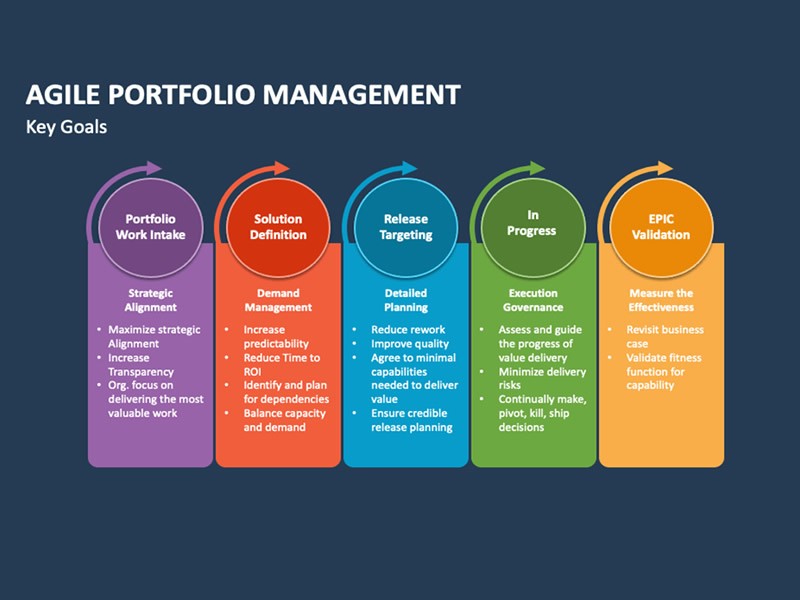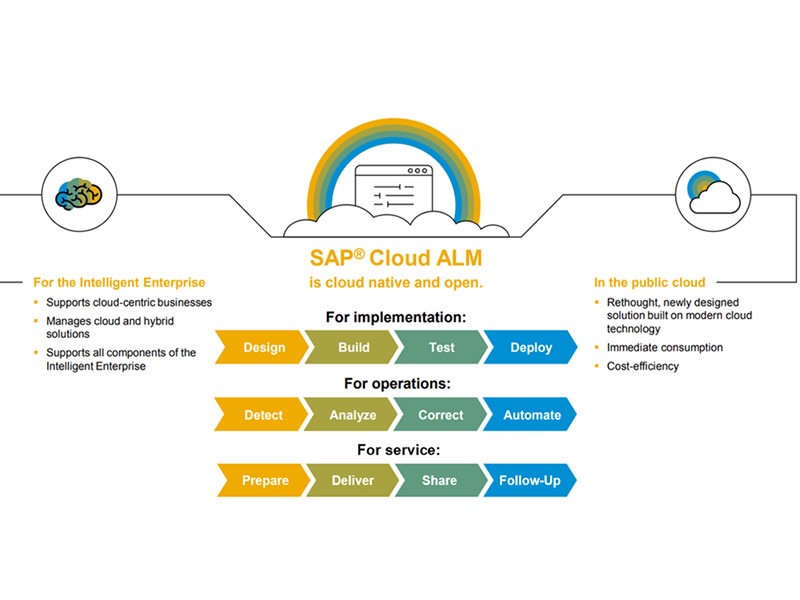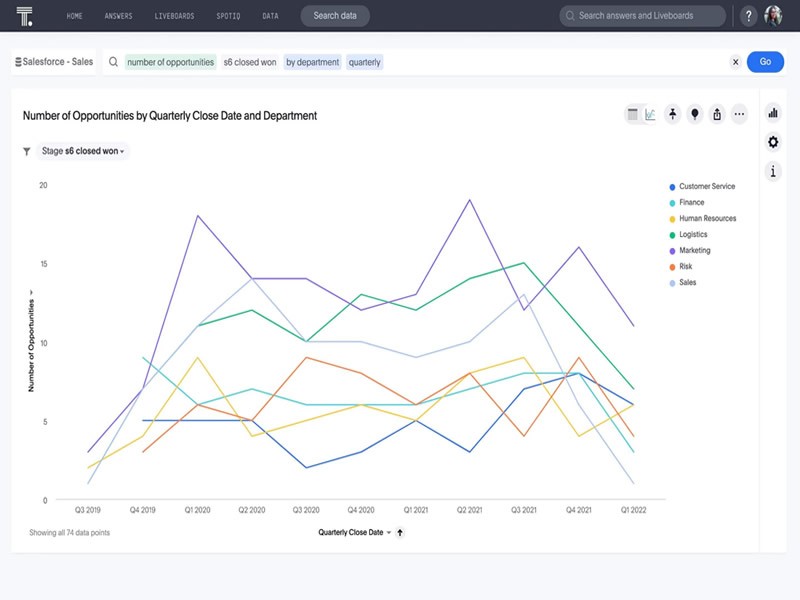Insight Blog
Agility’s perspectives on transforming the employee's experience throughout remote transformation using connected enterprise tools.
9 minutes reading time
(1775 words)
Elevating Agile Project Delivery with Agile Portfolio Management
Discover how Agile portfolio management can enhance your project delivery. Dive into strategies, benefits, and best practices to align teams and streamline processes.
You're halfway up the mountain as a project manager if you've mastered the Agile methodology for individual projects.
But why settle for efficiency in isolated silos when you can harmonize all your efforts and drive company-wide success?
Here's your straightforward, no-nonsense guide on elevating and improving your project delivery with Agile portfolio management.
What Is Agile?
Agile is a project management philosophy that involves the strategic alignment of separating projects into smaller chunks, heavily emphasizing continuous collaboration and improvement.
Here's a diagram that shows how this decentralized control works:
This simply means that Agile projects are more focused on improving gradually than moving on from one stage to the next.
Agile has been around since 2001 to address a crippling problem in businesses worldwide. Historically, the entire project management workflow was a primitive, exhausting, and inefficient process for most companies.
Here's an example. Let's say your marketing team wanted to do a complete website redesign.
Back then, a project manager would assemble a list of chronological tasks to guide all collaborators from start to finish. Sounds like a good business strategy on the surface, right? Well, this traditional project management format presents a wide range of problems.
These issues include:
- A linear approach to project management can create bottlenecks that delay projects and prevent future progress.
- Stakeholders and clients aren't in the loop, meaning customer satisfaction is low, and revisions are high.
- Most collaborators focus more on planning and creating documentation than focusing on what matters most — pleasing the end user.
On the other hand, the Agile methodology focuses on creating a revolving door for planning, executing, and revising to produce top-notch results and speed up project delivery times.
Now, imagine if, during the middle of that website redesign, the marketing team realized the necessity of adding multi-factor authentication for enhanced security.
Introducing such a last-minute change in a traditional project management setup could create chaos. The entire project timeline might need reworking, causing delays and overshooting budgets.
However, an Agile project management team would take this in stride. They'd prioritize the new requirement, break it into smaller tasks, and integrate it as soon as possible.
Why? Because they realize the value that this extra layer of protection provides to sensitive customer data. With flexibility and a focus on constant feedback, Agile delivers better project results. Every. Time.
What Is Agile Portfolio Management?
While there are many definitions available online, here's an easy-to-digest version.
Agile portfolio management zeroes in on an organization's approach to pinpointing, ranking, coordinating, and overseeing various products. The goal is to foster a seamless process that maximizes value creation while providing sustainability for the long haul.
In other words, when you adopt this methodology, you're better equipped to respond quickly to changes (across your customer base or within your market). That way, you can constantly provide value to their customers and drive business growth into perpetuity.
And with that, a few core principles build the foundation of Agile portfolio management.
Here's a closer look at this strategic alignment:
- Value-driven decisions. It's all about delivering maximum value. Every decision and pivot should steer toward offering your customers and stakeholders the utmost value.
- Empirical decision making. Trust your data. All decisions need "hard proof" and real-world observations.
- Stakeholder collaboration. Engaging stakeholders is a top priority. The goal? Everyone has a say.
- Adaptive planning. In Agile, planning is a dynamic process. You adjust and readjust as you gather more insights and information.
- Relentless improvement: Complacency? Not here. The goal is to always seek ways to enhance processes, deliverables, and value.
In short, Agile portfolio management promotes adaptability and flexibility. It encourages your team to embrace change and respond quickly to new information or shifting priorities.
The result? Your organization can stay ahead of the competition by capitalizing on emerging opportunities.
Benefits of Agile Portfolio Management
Adopting Agile methods brings a multitude of benefits to your organization.
One of the primary advantages is improved project delivery speed. By breaking down projects into smaller, manageable chunks, teams can help deliver value faster. And make the necessary adjustments at any point from A to Z.
The result? Your team can quickly respond to changing market conditions and customer demands.
Also, agile portfolio management fosters team collaboration and transparency. Regular communication and stakeholder involvement help your teams work together towards a common goal and achieve operational excellence.
This collaborative approach:
- Prevents things from slipping through the cracks.
- Keeps everyone on the same page.
- Enhances team productivity.
And finally, agile portfolio management works wonders in promoting risk management and mitigation. Through continuous monitoring and evaluation, your teams can identify potential risks early on and take proactive measures to minimize their impact.
This risk-aware approach allows for greater adaptability and resilience, reducing the likelihood of project failure. And when you can check more projects off your list, that drives better results and boosts your bottom line.
Follow us and access great exclusive content everyday: Follow us on Google News
How to Implement Agile Portfolio Management in Your Organization
Incorporating agile portfolio management into your workflows doesn't happen overnight. It requires a systematic approach and a cultural shift within your organization.
Here are some key steps to consider when switching to agile portfolio management.
You may also like: Best Apps for Employees: UPDATED 2022 – A Complete Guide
Step 1: Assess Your Current Portfolio
Before you get carried away dreaming about the agile wonders ahead, take a magnifying glass to your current project portfolio.
Do you know where all your projects stand? Are they aligned with your organization's strategic objectives?
If something isn't adding value, it's time to reconsider it. And remember, this isn't about pointing fingers at your weakest link. It's about starting fresh and prioritizing tasks to help you reach your business goals.
Step 2: Define Your Agile Portfolio Management Framework
Here's the deal. Agile isn't a one-size-fits-all solution. It's crucial to customize your agile framework to the unique needs and dynamics of your organization.
Will you lean more towards Scrum, Kanban, SAFe, or another approach? Identify the methods and frameworks that your team resonates with to help knock your goals out of the park.
And hey, if you're feeling a bit overwhelmed, reach out to the experts. There's a bustling community of Agile enthusiasts and consultants ready and willing to share their insights.
For example, seeking guidance from trusted SAP consulting experts is a surefire way to get the most out of the SAP Cloud ALM solution.
Their deep knowledge and experience in SAP will help you maximize the benefits of Agile methodologies, enhancing project delivery and driving overall success.
Free ebook: How To Get Your Intranet Off The Ground
Step 3: Establish a Governance Structure
Don't let the fancy term throw you off. Governance simply means setting clear guidelines on how to make good decisions. And making sure there's a clear line of sight from strategy to execution.
Think of it as putting up posters along your Agile journey. It guides your teams. Keeps everyone aligned. And motivates everyone to continue chugging along in the same direction.
Step 4: Train and Educate Your Teams
Let's be honest. Change is hard. But, it's a lot easier when everyone knows what's going on.
Invest in training sessions, workshops, and ongoing education. The more your teams understand the "why" and "how" behind Agile Portfolio Management, the more they'll champion it.
Knowledge is power. Use it to fuel your Agile transformation engine.
Step 5: Leverage Agile Portfolio Management Tools and Software
If you're still juggling two dozen spreadsheets or sticky notes, it's time for an upgrade.
Technology is here to make your life easier and do all the heavy lifting. The right tools will give you real-time visibility, collaboration features, and dashboards that break down complex information with data storytelling techniques.
Dive into the market, demo a few options, and find that perfect fit.
What Are the Main Challenges in Agile Portfolio Management?
While agile portfolio management offers numerous benefits, there are also some challenges.
Challenge 1: Resistance to Change
First things first. Change is hard, and not everyone's going to jump on the Agile bandwagon straight away.
Solution
Open communication. Create an environment where your team feels comfortable raising concerns. Answer these questions. And discuss the benefits. The goal? A transition from "Why are we doing this?" to "How can we make this work?
Challenge 2: Overcomplicating the Process
With so many Agile frameworks and tools out there, it's easy to find yourself in the trap of making things more complicated than they need to be.
Solution
Simplicity is your friend. Tailor your approach, but avoid the temptation to add every bell and whistle.
Challenge 3: Losing Sight of the Big Picture
Reaching deep into the Agile pool can sometimes make you lose sight of the end goal.
Solution
Regular check-ins. These help align individual projects with your broader organizational goals. Think of it as recalibration.
Challenge 4: Resource Overstretch
While Agile is about optimizing resources, there's a risk of spreading oneself too thin, especially when enthusiasm runs high.
Solution
Pace yourself. Prioritize tasks and projects. Prevent your team from task overload. Pay close attention to resource allocation. In other words, find your workload equilibrium.
Challenge 5: Tech Overload
Just because there's a shiny new Agile tool on the market doesn't mean it's right for your organization.
Solutions
Due diligence. Evaluate tools based on their fit with your organization's needs, not their list of fancy features. Find tools that offer user-friendly interfaces to provide a smooth transition. Organize your team into efficient shifts with team scheduling tools to simplify day to day operations.
Wrapping up
And there you have it. The whole nine yards on Agile portfolio management.
Beyond individual projects, it creates a roadmap of interlinked efforts, all aiming for a unified destination. A world where every project, regardless of its size, plays a role in a bigger narrative.
If you're already on the Agile project journey, this is your next step. Dive into Agile Portfolio Management and watch your projects truly come alive in harmony with one another.
Ready to take the leap as a portfolio manager?
Categories
Blog
(2616)
Business Management
(323)
Employee Engagement
(212)
Digital Transformation
(174)
Growth
(119)
Intranets
(115)
Remote Work
(61)
Sales
(48)
Collaboration
(36)
Project management
(29)
Culture
(28)
Customer Experience
(26)
Knowledge Management
(21)
Leadership
(20)
Comparisons
(6)
News
(1)
Ready to learn more? 👍
One platform to optimize, manage and track all of your teams. Your new digital workplace is a click away. 🚀
Free for 14 days, no credit card required.










![What Is an Intranet for Business? [2026 Guide] What Is an Intranet for Business? [2026 Guide]](http://agilityportal.io/images/easyblog_articles/1496/b2ap3_thumbnail_What-Is-an-Intranet-for-Business.png)





